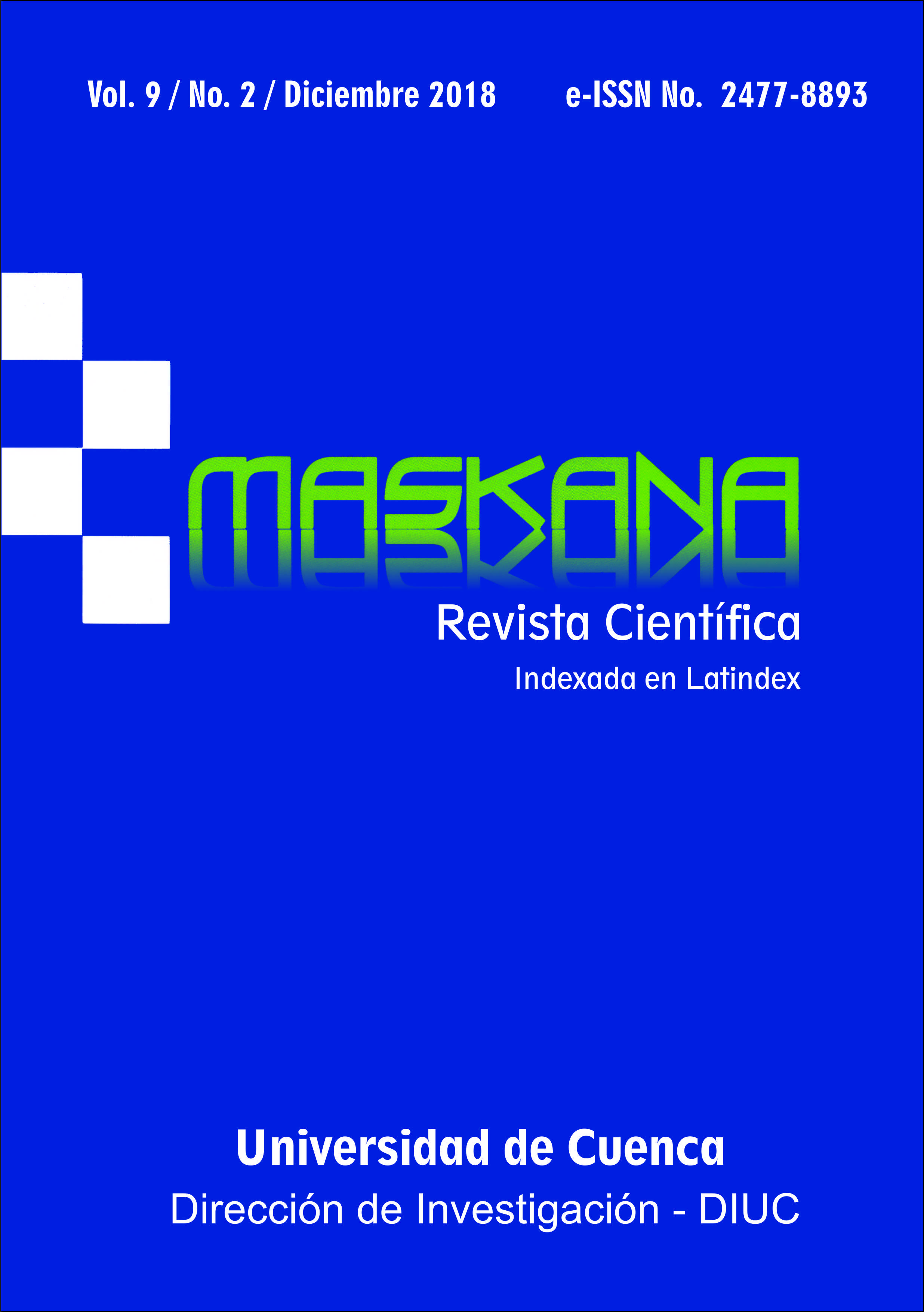Una provincia con varios climas: ¿Qué conocimiento de hidrología puede ser útil? Una revisión bibliográfica
DOI:
https://doi.org/10.18537/mskn.09.02.06Palabras clave:
hidrología, clima semiárido, sabana, trópicos húmedos, clasificación climática Köppen-Geiger, costa de Ecuador, ManabíResumen
El presente artículo explora el estado de la ciencia hidrológica que podría ser útil para una región con diversidad climática tal como lo es la provincia de Manabí en Ecuador. La provincia de Manabí, con un área de 18,940 km2, tiene una variedad de climas tropicales y secos. Primero, se lleva a cabo una revisión de las condiciones climáticas del área de estudio, ya que diferentes fuentes discrepan, en cierta medida, con respecto a los tipos de clima; luego, se lleva a cabo una evaluación crítica de la literatura hidrológica relevante. Aquí se encuentra que la literatura más adecuada para las condiciones de Manabí incluye literatura para hidrología semiárida, sabana y tropical húmeda. Aun cuando se encontró vacíos de investigación, también existe una cantidad significativa de conocimiento, utilizable como base en futuros estudios. Cabe señalar que gran parte de la literatura disponible se obtuvo con condiciones de vegetación y suelo que podrían diferir de las de Manabí. Por lo tanto, es esencial que resultados de otros sitios de estudio se contrasten con aquellos obtenidos en Manabí. El entendimiento del funcionamiento hidrológico en el área de estudio podría contribuir a la literatura de hidrología para climas semiárido, de sabana y tropical húmedo.
Descargas
Métricas
Citas
Al-Qurashi, A., McIntyre, N., Wheater, H., & Unkrich, C. (2008). Application of the Kineros2 rainfall-runoff model to an arid catchment in Oman. Journal of Hydrology, 355(1-4), 91-105. https://doi.org/10.1016/j.jhydrol.2008.03.022
Bartley, R., Roth, C. H., Ludwig, J., McJannet, D., Liedloff, A., Corfield, J., … Abbott, B. (2006). Runoff and erosion from Australia’s tropical semi-arid rangelands: influence of ground cover for differing space and time scales. Hydrological Processes, 20(15), 3317-3333. https://doi.org/10.1002/hyp.6334
Bowman, D. M. J. S., & Prior, L. D. (2005). Why do evergreen trees dominate the Australian seasonal tropics? Australian Journal of Botany, 53(5), 379-399. https://doi.org/10.1071/BT05022
Boy, J., Valarezo, C., & Wilcke, W. (2008). Water flow paths in soil control element exports in an Andean tropical montane forest. European Journal of Soil Science, 59(6), 1209-1227. https://doi.org/10.1111/j.1365-2389.2008.01063.x
Bruijnzeel, L. (1990). Hydrology of moist tropical forests and effects of conversion : A state of knowledge review. Paris, France: Unesco.
Bruijnzeel, L. (2001). Hydrology of tropical montane cloud forest: A reassessment. Land Use and Water Resources Research, 1(1.1), 1-18.
Bull, L., & Kirkby, M. (2002). Dryland rivers: Hydrology and geomorphology of semi-arid channels. England: Wiley.
Bull, L., Kirkby, M., Shannon, J., & Hooke, J. (2000). The impact of rainstorms on floods in ephemeral channels in southeast Spain. CATENA, 38(3), 191-209. https://doi.org/10.1016/S0341-8162(99)00071-5
Camarasa-Belmonte, A. M. (2016). Flash floods in Mediterranean ephemeral streams in Valencia Region (Spain). Journal of Hydrology, 541, 99-115. https://doi.org/10.1016/j.jhydrol.2016.03.019
Campling, P., Gobin, A., Beven, K., & Feyen, J. (2002). Rainfall-runoff modelling of a humid tropical catchment: The TOPMODEL approach. Hydrological Processes, 16(2), 231-253. https://doi.org/10.1002/hyp.341
Cavelier, J., & Goldstein, G. (1989). Mist and fog interception in elfin cloud forests in Colombia and Venezuela. Journal of Tropical Ecology, 5(3), 309-322. https://doi.org/10.1017/S0266467400003709
Chappell, N. A. (2010). Soil pipe distribution and hydrological functioning within the humid tropics: A synthesis. Hydrological Processes, 24(12), 1567-1581. https://doi.org/10.1002/hyp.7579
Chappell, N. A., Franks, S. W., & Larenus, J. (1998). Multi-scale permeability estimation for a tropical catchment. Hydrological Processes, 12(9), 1507-1523. https://doi.org/10.1002/(SICI)1099-1085(199807)12:9<1507::AID-HYP653>3.0.CO;2-J
Chevallier, P., & Planchon, O. (1993). Hydrological processes in a small humid savanna basin (Ivory Coast). Journal of Hydrology, 151(2-4), 173-191. https://doi.org/10.1016/0022-1694(93)90235-2
Cook, P. G., Hatton, T. J., Pidsley, D., Herczeg, A. L., Held, A., O’Grady, A., & Eamus, D. (1998). Water balance of a tropical woodland ecosystem, Northern Australia: A combination of micro-meteorological, soil physical and groundwater chemical approaches. Journal of Hydrology, 210(1-4), 161-177. https://doi.org/10.1016/S0022-1694(98)00181-4
Crespo, P., Bücker, A., Feyen, J., Vaché, K. B., Frede, H. G., & Breuer, L. (2012). Preliminary evaluation of the runoff processes in a remote montane cloud forest basin using Mixing Model Analysis and Mean Transit Time. Hydrological Processes, 26(25), 3896-3910. https://doi.org/10.1002/hyp.8382
de Araújo, J., & González, J. (2009). Comparative hydrology: analysis of a semiarid and a humid tropical watershed. Hydrological Processes, 23(1), 1169-1178. https://doi.org/10.1002/hyp.7232
Dubreuil, P. (1985). Rreview of field observation of runoff generation., 80.
Dunkerley, D., & Brown, K. (1999). Flow behaviour, suspended sediment transport and transmission losses in a small (sub-bank-full) flow event in an Australian desert stream. Hydrological Processes, 13(11), 1577-1588. https://doi.org/10.1002/(SICI)1099-1085(19990815)13:11<1577::AID-HYP827>3.0.CO;2-L
Farrick, K. K. (2014). Runoff generation in a tropical dry forest watershed: Processes, patterns and connectivity. Doctoral thesis, The University of Western Ontario, Canada. Retrieved from http://ir.lib.uwo.ca/etd/2523%5Cnhttp://ir.lib.uwo.ca/cgi/viewcontent.cgi?article=4003&context=etd%5Cnhttp://ir.lib.uwo.ca/etd/2523/
Farrick, K. K., & Branfireun, B. A. (2013). Left high and dry: A call to action for increased hydrological research in tropical dry forests. Hydrological Processes, 27(22), 3254-3262. https://doi.org/10.1002/hyp.9935
Farrick, K. K., & Branfireun, B. A. (2014). Infiltration and soil water dynamics in a tropical dry forest: It may be dry but definitely not arid. Hydrological Processes, 28(14), 4377-4387. https://doi.org/10.1002/hyp.10177
Feyen, J., Milia, M., Van-Hoof, H., Quinde, K., Ochoa, V., & Bojorque, J. (2016). Improving the publication visibility of Ecuador ’ s higher education system, Maskana, 7(2), 113-125.
Fleischbein, K., Wilcke, W., Valarezo, C., Zech, C., & Knoblich, K. (2006). Water budgets of three small catchments under montane forest in Ecuador: experimental and modelling approach. Hydrological Processes, 20(1), 2491-2507. https://doi.org/10.1002/hyp.6212 Water
García-Pintado, J., Barberá, G. G., Erena, M., & Castillo, V. M. (2009). Calibration of structure in a distributed forecasting model for a semiarid flash flood: Dynamic surface storage and channel roughness. Journal of Hydrology, 377(1-2), 165-184. https://doi.org/10.1016/j.jhydrol.2009.08.024
Goller, R., Wilcke, W., Leng, M. J., Tobschall, H. J., Wagner, K., Valarezo, C., & Zech, W. (2005). Tracing water paths through small catchments under a tropical montane rain forest in south Ecuador by an oxygen isotope approach. Journal of Hydrology, 308(1-4), 67-80. https://doi.org/10.1016/j.jhydrol.2004.10.022
Hernandez-Jimenez, A., Vera-Macias, L., Naveda-Basurto, C., Guzman-Cedeno, A., Vivar-Arrieta, M., Zambrano, T., … Lopez-Alava, G. (2017). Variaciones en algunas propiedades del suelo por el cambio de uso de la tierra, en las partes media y baja de la microcuenca Membrillo, Manabi, Ecuador. Cultivos Tropicales, 38(1), 50-56. Retrieved from http://scielo.sld.cu/scielo.php?script=sci_arttext&pid=S0258-59362017000100006&lng=en&nrm=iso.com&tlng=es
Hughes, D., Heal, K., & Leduc. (2017). Improving the visibility of hydrological sciences from developing countries. Hydrological Sciences Journal - Journal Des Sciences Hydrologiques, 59(9), 1627-1635. https://doi.org/10.1080/02626667.2014.938653
INEC. (2010). Resultados del de población y vivienda Censo 2010 en el Ecuador. Retrieved from http://www.ecuadorencifras.gob.ec/wp-content/descargas/Manu-lateral/Resultados-provinciales/manabi.pdf
INEC, Naranjo, L., Chaves, R., Salazar, D., Orejuela, D., Cuichán, M., … Villafuerte. (2012). Encuesta de superficie y producción agropecuaria continua 2012. Inec. Retrieved from http://www.ecuadorencifras.gob.ec/documentos/web-inec/Estadisticas_agropecuarias/espac/espac_2012/InformeEjecutivo.pdf
Kinner, D. A., & Stallard, R. F. (2004). Identifying storm flow pathways in a rainforest catchment using hydrological and geochemical modelling. Hydrological Processes, 18(15), 2851-2875. https://doi.org/10.1002/hyp.1498
Kottek, M., Grieser, J., Beck, C., Rudolf, B., & Rubel, F. (2006). World map of the Köppen-Geiger climate classification updated. Meteorologische Zeitschrift, 15(3), 259-263. https://doi.org/10.1127/0941-2948/2006/0130
Li, X., Niu, J., & Xie, B. (2014). The effect of leaf litter cover on surface runoff and soil erosion in Northern China. PLoS ONE, 9(9). https://doi.org/10.1371/journal.pone.0107789
Vose, J. M., & Maass, J. M. (1999). Comparative nalysis of hydrologic responses of tropical deciduous and temperate deciduous watershed to climatic change. In: C. Aguirre-Bravo, F. C. Rodriguez (Eds.). North American science Symposium: toward a unified framework for inventorying and monitoring forest ecosystem resources; 1998 November 2-6; Guadalajara, Mexico. Proceedings RMRS-P-12. Fort Collins, CO: U.S. Department of Agriculture, Forest Service, Rocky Mountain Research Station: 292-298
Maneta, M., Schnabel, S., & Jetten, V. (2008). Continuous spatially distributed simulation of surface and subsurface hydrological processes in a small semiarid catchment. Hydrological Processes, 22(13), 2196-2214. https://doi.org/10.1002/hyp.6817
McIntyre, N., & Al-Qurashi, A. (2009). Performance of ten rainfall-runoff models applied to an arid catchment in Oman. Environmental Modelling and Software, 24(6), 726-738. https://doi.org/10.1016/j.envsoft.2008.11.001
Molicova, H., Grimaldi, M., Bonell, M., & Hubert, P. (1997). Using Topmodel towards identifying and modeling thehydrological patterns within a headwater,humid, tropical catchment. Hydrological Processes, 11(April 1996), 1169-1196.
Montenegro, A., & Ragab, R. (2010). Hydrological response of a Brazilian semi-arid catchment to different land use and climate change scenarios: A modelling study. Hydrological Processes, 24(19), 2705-2723. https://doi.org/10.1002/hyp.7825
Moya, R. (2006). Climas del Ecuador. Quito, Ecuador: INAMHI. Retrieved from http://186.42.174.231/gisweb/METEOROLOGIA/CLIMATOLOGIA/Climas del Ecuador 2006.pdf
OAS, Republica del Ecuador, CRM, INERHI, & CONADE. (1991). Plan integral de desarrollo de los recursos hídricos de la Provincia de Manabi. Washington, D.C. Retrieved from https://www.oas.org/DSD/publications/Unit/oea40s/begin.htm#Contents
Park, A., Friesen, P., & Serrud, A. A. S. (2010). Comparative water fluxes through leaf litter of tropical plantation trees and the invasive grass Saccharum spontaneum in the Republic of Panama. Journal of Hydrology, 383(3-4), 167-178. https://doi.org/10.1016/j.jhydrol.2009.12.033
Peel, M. C., Finlayson, B. L., & McMahon, T. A. (2007). Updated world map of the Köppen-Geiger climate classification. Hydrology and Earth System Sciences, 11(5), 1633-1644. https://doi.org/10.1127/0941-2948/2006/0130
Petheram, C., Rustomji, P., McVicar, T. R., Cai, W., Chiew, F. H. S., Vleeshouwer, J., … Perraud, J.-M. (2012). Estimating the impact of projected climate change on runoff across the tropical savannas and semiarid rangelands of Northern Australia. Journal of Hydrometeorology, 13(2), 483-503. https://doi.org/10.1175/JHM-D-11-062.1
Pourrut, P. (1994). L’eau en Equateur: principaux acquis en hydroclimatologie. Paris, France: ORSTOM. Retrieved from https://core.ac.uk/download/pdf/39856198.pdf
Rossel, F., Cadier, E., & Gomez, G. (1996). Las inundaciones en la zona costera ecuatoriana: causas; obras de proteccion existentes y previstas. Bulletin de l’Insitut Français d’Études Andines, XXV, 3, (January 1996), 339-420.
Rossel, F., Goulven, P. Le, & Cadier, E. (1999). Répartition spatiale de l'influence de l' ENSO sur les précipitations annuelles en Equateur. Revue des Sciences de l'Eau, 12(1), 183-200. https://doi.org/10.7202/705348ar
Rubel, F., & Kottek, M. (2010). Observed and projected climate shifts 1901-2100 depicted by world maps of the Köppen-Geiger climate classification. Meteorologische Zeitschrift, 19(2), 135-141. https://doi.org/10.1127/0941-2948/2010/0430
Sempertegui, J., Torres, G., Gallardo, G., & Hernández, A. (1990). Estado actual del desarrollo de la Ciencia y Tecnología en el Ecuador. Retrieved from http://repositorio.educacionsuperior.gob.ec/bitstream/28000/993/1/T-SENESCYT-0199.pdf
Shaw, E., Beven, K., Chappel, N., & Lamb, R. (2010). Hydrology in practice (4th ed.). CRC Press.
Sierra, R. (1999). Propuesta preliminar de un sistema de clasificación de vegetación para el Ecuador Continental. Retrieved from http://www.academia.edu/2081344/Propuesta_preliminar _de_un_sistema_de_clasificación_de_vegetación_ para_el_Ecuador_Continental_proyecto_INEFAN_GEF-BIRF_y_EcoCiencia_Preliminary_ https://doi.org/10.13140/2.1.4520.9287
Simmers, I. (2003). Understanding water in a dry environment:Hydrological processes in arid and semi-arid zones. IAH International Contributions to Hydrogeology 23. Publisher: A. A. Balkema. Retrieved from http://web.sahra.arizona.edu/swhydro/archive/V3_N2/dept-inprint.pdf
Smith, T. M., & Smith, R. L. (2007). Ecología (6th ed.). Madrid, España: Pearson Addison Wesley.
van Schaik, N. L. M. B., Schnabel, S., & Jetten, V. G. (2008). The influence of preferential flow on hillslope hydrology in a semi-arid watershed (in the Spanish Dehesas). Hydrological Processes, 22(18), 3844-3855. https://doi.org/10.1002/hyp
Ward, R. C., & Robinson, M. (2000). Principles of hydrology (4th ed.). London, UK: McGraw-Hill Publishing Co.
Wohl, E., Barros, A., Brunsell, N., Chappell, N. A., Coe, M., Giambelluca, T., …, Ogden, F. (2012). The hydrology of the humid tropics. Nature Climate Change, 2(9), 655-662. https://doi.org/10.1038/nclimate1556
Yatheendradas, S., Wagener, T., Gupta, H., Unkrich, C., Goodrich, D., Schaffner, M., & Stewart, A. (2008). Understanding uncertainty in distributed flash flood forecasting for semiarid regions. Water Resources Research, 44(5), 1-17. https://doi.org/10.1029/2007WR005940
Descargas
Publicado
Cómo citar
Número
Sección
Licencia
Copyright © Autors. Creative Commons Attribution 4.0 License para cualquier artículo enviado a partir del 6 de junio de 2017. Para los manuscritos presentados anteriormente, se utilizó la licencia CC BY 3.0.
![]()
Usted es libre de:
 |
Compartir — compartir y redistribuir el material publicado en cualquier medio o formato. |
 |
Adaptar — combinar, transformar y construir sobre el material para cualquier propósito, incluso comercialmente. |
Bajo las siguientes condiciones:
 |
Atribución — Debe otorgar el crédito correspondiente, proporcionar un enlace a la licencia e indicar si se realizaron cambios. Puede hacerlo de cualquier manera razonable, pero de ninguna manera que sugiera que el licenciador lo respalda a usted o a su uso. |
| Sin restricciones adicionales: no puede aplicar términos legales o medidas tecnológicas que restrinjan legalmente a otros a hacer cualquier cosa que permita la licencia. |
Mayor información sobre este acuerdo de autoría y licencia, transferencia de derechos o solicitudes de reproducción, pueden ser consultados en este enlace.









